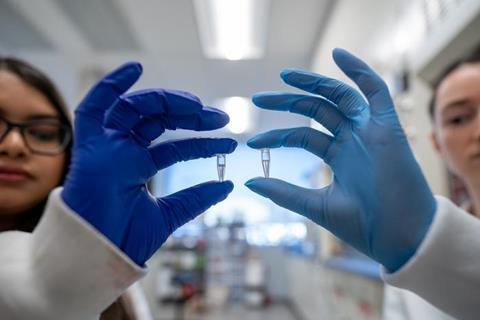A novel new test for bacteria in fluids makes it as easy as observing a colour change to confirm the presence of disease-causing pathogens, promising much easier diagnostic tests and greater food safety.

Engineers and biochemists at McMaster University have brought their skills together to make it possible for untrained users to confirm contamination in fluids using a biogel test that changes colour in the presence of such bacteria as E. coli, listeria and other frequent testing targets.
The test uses harmless bacteriophages embedded in the gel to locate target bacteria in a sample of fluid such as lake water, urine or a container of milk, even in low concentrations.
Phages in action
Bacteriophages are the most common form of life on Earth. Each form of bacteriophage is specialized to destroy one form of bacteria.
READ MORE: Phages help to identify people at risk of developing TB
READ MORE: Dr Ben Swift named as winner of Basil Jarvis Prize
In the test, phages – as they are called informally – find and attack the target bacteria in a sample, causing the bacteria to release microscopic amounts of intracellular material which the test can read, triggering a colour change that is readily visible to the eye. If the sample is clean, the colour stays the same.
The new process takes just hours, producing results much more quickly than lab cultures, which can take two days to generate results.
Destructive power
“We’ve been using phages’ destructive power to kill bacteria and resolve infections for years,” says Zeinab Hosseinidoust, an associate professor of biomedial and chemical engineering who holds the Canada Research Chair in Bacteriophage Bioengineering. “Here, we’re channelling that power in another way. Because phages can burst bacteria open, they can give us quick access to the biological components of those bacteria that we use to confirm their presence.”
The test, described in a new paper published in the journal Advanced Materials, is the latest in a series of technologies the group has developed, all aimed at placing simple technology within reach of producers, retailers, consumers and medical professionals.
“Now we have a tool that can be used in food samples, environmental samples and clinical samples,” says corespounding author Tohid Didar, an associate professor of mechanical and biomedical engineering who holds the Canada Research Chair in Nano-Biomaterials. “Today, people who suspect they may have a urinary-tract infection must visit a doctor and sometimes wait days for a result. This technology would make it very easy for people to tests themselves at home and get a result in a matter of hours.”
Canon of work
The group’s previous work includes creating a portable testing library to match phages to otherwise untreatable antibiotic-resistant infections, a contamination test incorporated into food packaging, and a temperature-stable storage system for live vaccines.
The group confirmed the concept of their newest test using urine samples from patients at Hamilton Health Sciences, and in all cases, results from the experimental test produced the same results as traditional lab tests. The test also worked accurately to detect E. coli in lake water samples.
The new test can be adapted to any bacterium by using bacteriophages and DNA probes that specifically target microbes such as listeria and salmonella.
Knock and enter
“Phages can knock on every biological door, but they will only enter the ones they are programmed to find,” says Carlos Filipe, a professor of chemical engineering and a senior author on the paper. “That specificity is a huge advantage for quick and precise detection, even at low levels.”
Such a test could have provided early and accurate detection in the recent listeria contamination of plant-based milk that killed two, sickened 10 and caused wide recalls in Canada, the researchers say.
“This technology could be helpful in rapidly limiting outbreaks ,” says co-author Akansha Prasad, a Vanier Scholar and PhD student in biomedical engineering. “If you had something in your fridge that you were concerned about, this test could let you know if it was safe for consumption.”
Testing for contamination
Testing for contamination in complex fluids such as milk, blood or urine is especially challenging, making simple, reliable alternatives such as the new test very useful, say the researchers, who hope to work with commercial partners to bring the technology to the marketplace.
“Once we have the appropriate approvals and partnerships to move this test to market, it could be very useful in many settings,” says the paper’s lead author Hannah Mann, a PhD student in chemical engineering and bioengineering. “About 12 per cent of Canadians don’t have access to municipal piped water, for example, and this could bring them a lot of peace of mind.”
The paper’s other authors are Yingfu Li, Shadman Khan, Feresheteh Bayat, Jimmy Gu and Kyle Jackson.







No comments yet